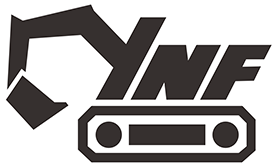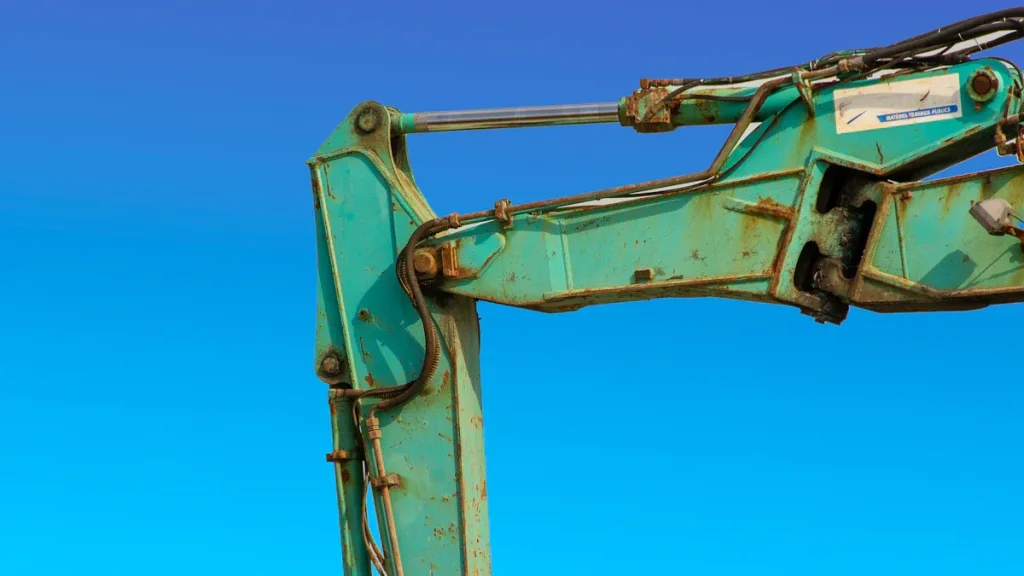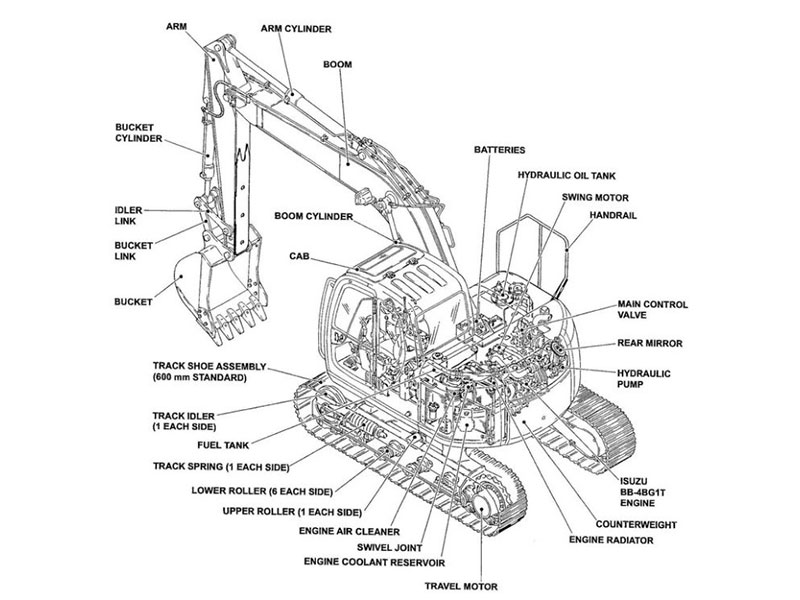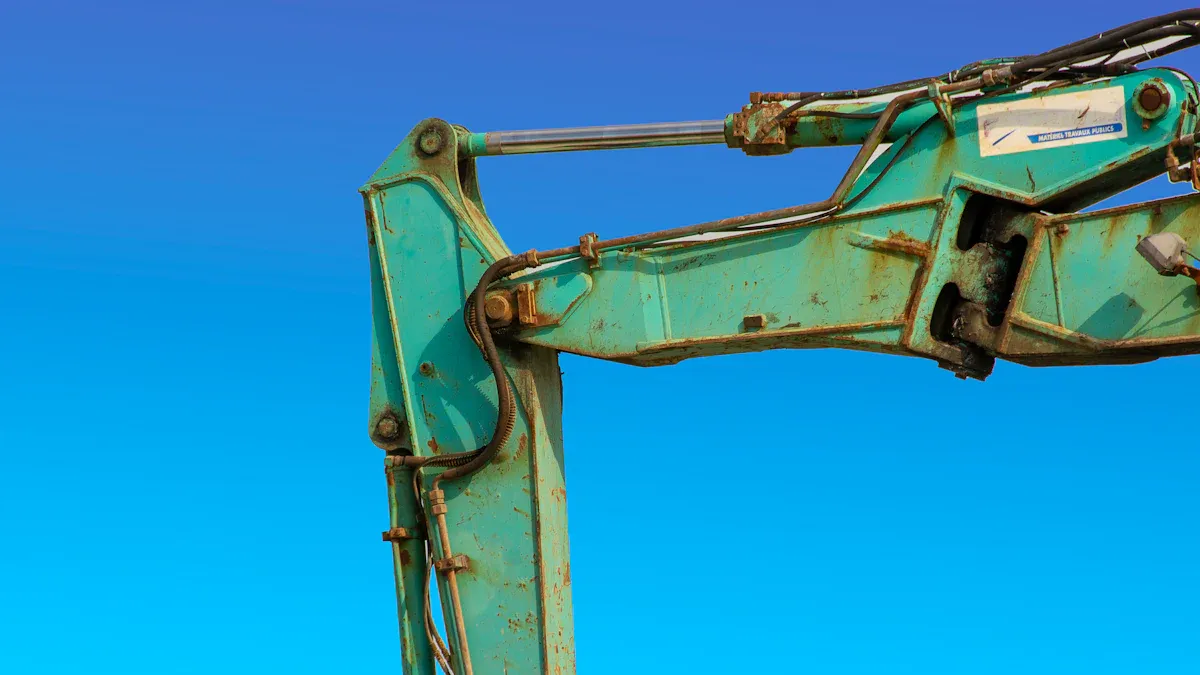
An excavator boom is a very important part of construction machines. This hydraulic-powered arm helps the machine reach, lift, and move things. It holds up the arm and bucket for digging, lifting, and loading. The design of an excavator boom has special safety features and monitoring systems. These help workers do their jobs more carefully and safely. There are different types of excavator parts boom. They help keep the machine steady and safe. This lowers the chance of accidents and helps workers do their jobs faster. Taking good care of the boom helps it last longer and work safely.
Key Takeaways
The excavator boom is a strong arm that uses hydraulics. It helps dig, lift, and move heavy things safely. It also works quickly and well.
There are different boom types. These include standard, long-reach, and two-piece. Each type fits different jobs and places. This helps the machine work better.
Operators must follow safety rules. They should use load charts to stop accidents. This keeps the boom working right.
Doing regular care, like greasing and checking, helps the boom last longer. It also stops expensive repairs.
Picking the right boom and taking care of it is important. It helps workers finish jobs faster. It also makes job sites safer.
Excavator Parts Boom Overview

Excavator Boom Definition
An excavator boom is a hydraulic-powered arm. It connects to the main body of the machine. This part lets the excavator reach out and lift things. The boom is the first part in the digging setup. It holds up both the arm and the bucket. Many construction sites use the excavator parts boom for heavy lifting and digging. It also helps move materials around. Sometimes, a factory changes the excavator boom for special jobs. This can help it dig deeper or lift heavier things.
Note: The excavator boom is made of more than one part. It works with other pieces to get the job done. Each piece has its own job and connects to the rest. This helps everything work smoothly.
Here is a table that lists the main parts and how they work together:
Component | Description | Interaction with Other Parts |
|---|---|---|
Boom | Main part that sticks out from the machine’s body. It gives reach and height. | Connects to the house. It holds the arm and bucket. |
Arm (Stick) | Joins the boom to the bucket. It controls how deep and far you can dig. | Has its own hydraulic cylinder. It helps move the bucket just right. |
Bucket | Used for digging and carrying stuff. | Hooks onto the arm. The bucket cylinder moves it. |
Hydraulic System | Made of pumps, valves, hoses, and cylinders. It makes things move. | Runs the boom, arm, and bucket. It lets you control them exactly. |
Boom Cylinder | A hydraulic cylinder between the boom and the house. It moves the boom up and down. | Lets you lift and lower the boom. |
Cab | Where the operator sits and controls the machine. | Controls all the hydraulic parts. |
Undercarriage | Keeps the machine steady while it works. | Holds up the whole machine. |
Structure and Connection
The excavator parts boom connects to the main body with strong steel hinges. These hinges have tough bearings and extra-strong joints. The boom is shaped like a closed box. It is made from strong steel plates. Engineers put ribs inside the boom to make it stronger. This stops it from bending or twisting. The boom cylinder connects at special hinge spots. One hinge is on the turntable flange. Another hinge is in the middle of the boom. This setup helps the excavator boom lift heavy things and stay steady.
A factory-changed excavator boom often has more support and better welding. Makers use ultrasonic tests to look for cracks. This keeps the boom safe during hard work. Engineers also use computer models to check the boom’s strength. They use these tests to make the design better. These steps help the excavator parts boom last longer and work well in many places.
Primary Function of the Excavator Boom
Digging and Lifting
The main job of the excavator boom is digging and lifting. It works like a strong arm with hinges. This arm sticks out from the machine’s body. The excavator boom moves the bucket or other tools up and down. The hydraulic system gives the boom the power it needs. This helps it do tough jobs. The boom is made to handle different weights and reach many depths.
Excavator booms are important for many jobs. They help dig trenches, move dirt, and lift heavy things. How deep you can dig depends on the boom and arm length. Longer booms can dig deeper holes. But they might not lift as much weight. This is because of leverage. The size of the excavator, engine power, and hydraulic system also matter. These things decide how much the boom can lift or dig.
Makers set safe weight limits for every excavator boom. These limits depend on the boom length, how far it reaches, and ground strength. Operators must look at load charts to stay safe. They should not lift more than the safe limit. Good rigging and steady ground are needed for safety. Heavy tools, like big buckets, can lower how much the boom can lift. This happens because the center of gravity changes.
Here are some things that affect digging and lifting:
Hydraulic system power controls how much you can lift.
Boom and arm length change reach and lifting strength.
Stability, like undercarriage design, keeps things safe.
Attachments change balance and lifting ability.
Excavator size and engine power affect how well it works.
Different boom types help with different jobs. A standard boom is good for most building work. A long-reach boom digs deeper but lifts less. High-reach booms are for tearing down tall things. Stronger booms break rocks. Each kind is made for a special job.
Boom Type | Key Characteristics | Effect on Digging and Lifting Ability | Typical Applications |
|---|---|---|---|
Standard Boom | Balanced reach and depth | Good for most digging and lifting tasks | General construction, grading, loading |
Long Reach Boom | Extended length | Deep digging, less lifting power | Dredging, slope work, environmental cleanup |
High Reach Boom | Vertical reach for tall structures | Safe demolition at height | Demolition of buildings |
Telescopic Boom | Adjustable length | Precise reach, useful in tight spaces | Confined area work, variable depth digging |
Swamp/Wetland Boom | Stability on soft ground | Improved digging and lifting in wet areas | Wetlands, marshes, soft terrain |
Rock Breaker Boom | Reinforced for impact | Handles heavy-duty operations like rock breaking | Mining, quarrying, demolition |
Reach and Elevation
How far and high an excavator boom can go is called reach and elevation. Standard excavators have a short boom for most jobs. These machines can dig, load, and move things in small spaces. But their reach and height are not as much as special models.
Long-reach and high-reach booms can go farther. Long-reach booms can stretch up to 20 meters. This helps with dredging, deep digging, and working around things. High-reach booms can go up to 15 meters high. These are used for tearing down tall buildings.
The boom design helps workers do more without moving the machine. This saves time and makes work faster. Higher booms help you see better. This makes it easier to load tall trucks or dig deep holes. Workers can move things more carefully. This is important for demolition or working in tight spots.
Many things affect how far and high the boom can go:
Machine size and hydraulic power set safe limits.
Strong parts make sure the boom can handle the work.
Counterweights and undercarriage help keep the machine steady.
Good visibility and controls help workers do the job right.
Engineers must balance reach, height, and safety when making a boom. Making the boom longer or taller adds weight. This can make the machine less steady and slower. The shape of the boom also matters. Curved booms help balance and clear obstacles. Hiding hydraulic hoses inside the boom keeps them safe and working well.
Tip: Operators should always check the maker’s load charts before lifting heavy things. Never go over the safe limit. This can cause tipping or damage.
The reach and height of the excavator boom make it useful for many jobs. These include digging trenches, tearing down buildings, dredging, and working in hard places. Picking the right boom helps workers match the machine to the job.
Excavator Boom and Arm
How They Work Together
The excavator boom and arm make a strong team at work. The boom is the main arm that sticks out from the machine. The arm, or stick, connects to the end of the boom. These two parts decide how far the machine can reach and how deep it can dig.
The boom and arm move together to guide the bucket.
The boom gives most of the reach and lifting strength.
The arm adds more reach and helps set digging depth.
Both parts use hydraulic cylinders to move at once.
Operators can lift the boom, stretch the arm, and use the bucket all at the same time.
This teamwork helps the boom and arm dig, grade, and lift with care. The operator uses controls in the cab to move each part. The design lets the boom and arm work together smoothly. This makes hard jobs easier and keeps workers safe.
Hydraulic Movement
Hydraulic movement gives the boom and arm their power and flexibility. Hydraulic cylinders link the cab, boom, arm, and bucket. Pressurized fluid moves through these cylinders to create force. The boom holds up the arm, and both move together to place the bucket where it is needed.
The hydraulic system is like the heart of the machine. A pump makes pressure, and valves send fluid to the right cylinders. This setup lets the boom and arm move together perfectly. Operators can make small changes or lift heavy things easily. The system keeps the machine steady and accurate, even during tough digging or lifting.
The boom and arm need this hydraulic power for every job. When the boom moves out or in, the arm and bucket follow in a smooth way. This teamwork is important for safe and fast work. The arm, held by the boom, can dig at many angles and depths because of the exact hydraulic controls.
Types of Excavator Booms
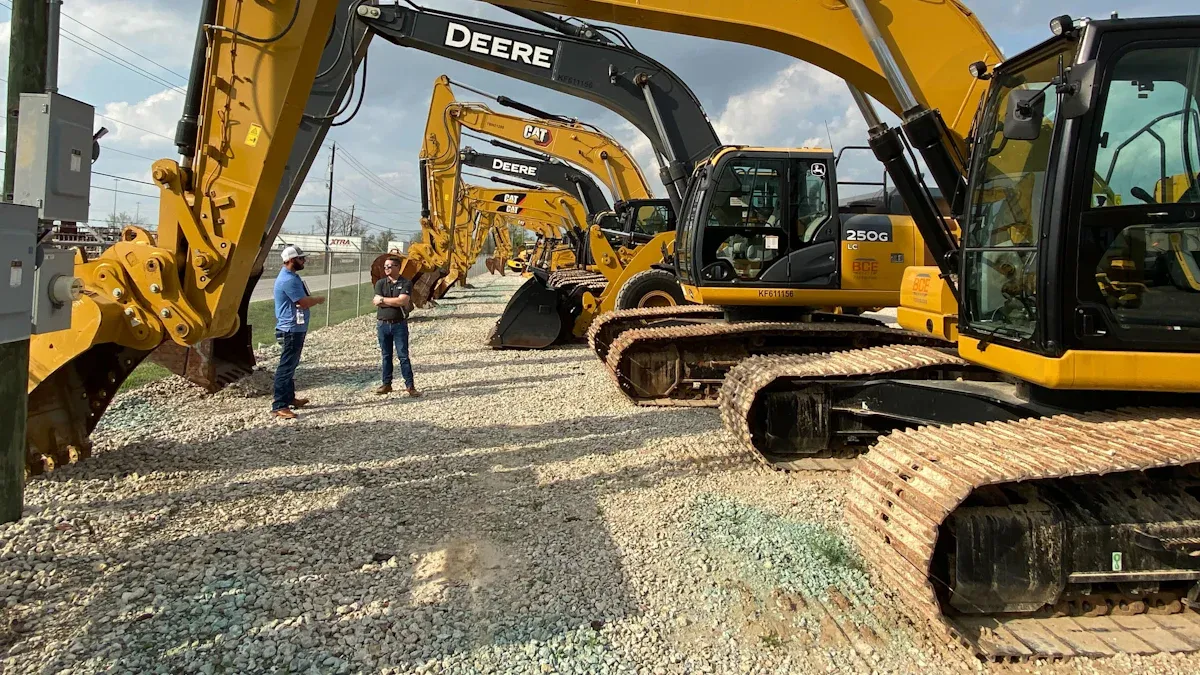
Excavator booms have different shapes and designs. Each one is made for certain jobs and places. The main types are standard mono boom, two-piece boom, and long-reach or telescopic boom. These choices help workers pick the right boom for their work.
Mono Boom
The standard mono boom is the most used type. It is made from one curved steel piece. This gives the machine good strength and balance. Workers use the mono boom for digging, trenching, and moving dirt. It works well for many jobs, like making foundations or loading trucks. The mono boom is a strong and trusted choice for building sites. With the right tools, it can also help with high reach demolition.
Two-Piece Boom
A two-piece boom is also called a knuckle boom. It has two parts that bend at a joint. This lets the boom move in more ways. Workers can reach tricky spots and odd angles. The two-piece boom is great for small spaces or near buildings. It helps with city jobs and landscaping. The table below shows how the two-piece boom is different from the mono boom:
Feature | Two-Piece Boom (Knuckle Boom) | Mono Boom (Standard) |
|---|---|---|
Design | Two parts with an extra joint | One curved piece |
Flexibility | Moves more ways, easier to handle | Moves less, not as flexible |
Operational Range | 15-20% more space to work | Normal working space |
Suitability | Good for tight spots, city work, landscaping | Good for digging, trenching, moving dirt |
Maneuverability | Easier near things in the way | Strong and steady |
Application Focus | Best for tricky or small places | Best for most digging jobs |
Long-Reach and Telescopic
Some jobs need a boom that can reach farther or move in special ways. The long-reach boom goes out farther than other booms. Workers use it for deep holes, loading trucks, or tearing down tall things. It is good for jobs like cleaning rivers or knocking down buildings. Long-reach booms are often on special machines. These machines have wide bases and cabs that tilt for safety.
Telescopic booms have parts that slide in and out. This lets workers get close or reach far away. Telescopic booms are good for city jobs or small work areas. Workers can spin the boom all the way around without bumping into things. But these booms are heavier and need more controls. The table below shows the good and bad points:
Boom Type | Advantages | Disadvantages |
|---|---|---|
Long-Reach Boom | Goes farther for deep digging and tall demolition. Good for special jobs. Safer and more stable. | Not as steady, can’t lift as much, can’t use big tools, hard to move. |
Telescopic Boom | Works close to the machine, easy to see, spins all the way, digs strong near the machine. | Heavier, harder to use, can’t lift as much. |
Workers pick the boom type based on what the job needs. Each boom helps with different work, from tearing down tall things to working in small spaces.
Importance of Excavator Booms
Performance and Safety
Excavator booms are important for how well and how safely a machine works. The way the boom is built changes how much it can lift. It also affects how safe it is during hard jobs. Some safety features are strong joints, tough welds, and special systems that watch for problems. These help stop accidents before they happen. Operators must follow strict rules to stay safe. OSHA makes these rules for job sites. Workers need training to learn about machine controls and how to dig safely. Training also teaches how to take care of equipment. These lessons show how safety features protect people and the work area.
Note: Certification programs, like OSHA Excavator Operator Certification, teach operators about safety, rules, and how to care for machines. Employers must make sure every operator gets trained and certified.
Aspect | Details |
|---|---|
Applicable OSHA Standards | 29 CFR 1926 Subpart P; 29 CFR 1926.600(a)(3)(i) |
Certification Programs | OSHA Excavator Operator Certification; Backhoe/Bobcat/Excavator Safety Certification |
Certification Focus | Operator training, safety protocols, equipment maintenance, compliance with OSHA regulations |
Purpose of Certification | Ensures operators are competent and certified to safely operate excavators and related equipment |
Relation to Boom Safety | Safety standards for excavator boom operation are implicitly covered as part of overall machine safety and OSHA compliance |
Training Content | Machine controls, excavation techniques, safety protocols, equipment maintenance, industry regulations |
Enforcement Responsibility | Employers must ensure operators are trained and certified according to OSHA standards |
Material Strength and Durability
Makers use strong steel and special welding to build excavator booms. These materials make the boom tough, flexible, and able to fight rust. For hard jobs, like high reach demolition, some booms use even stronger steel and extra support. The kind of steel changes how long the boom lasts. It also changes how well it handles stress. High-tensile and wear-resistant steels help stop cracks and damage. Some booms have special coatings to keep away rust and weather.
High-strength steels (like ASTM A514) are strong and not too expensive.
Quenched and tempered steels make the boom tougher and last longer.
Wear-resistant steels help the boom last in rough jobs.
Factory modified excavator boom designs add more strength for hard work.
Maintenance Tips
Doing regular maintenance keeps excavator booms safe and working right. Operators should put grease on boom cylinders and pins every 50 to 100 hours. This helps stop parts from wearing out. Inspections help find cracks or dents early. Checking by looking, measuring, and using special scans can find hidden problems. For hard jobs, like high reach demolition, extra care helps stop cracks and damage.
Clean and grease moving parts when needed.
Use special tools to check for worn spots.
Listen for strange sounds or shakes during work.
Teach workers to spot problems early.
Write down all maintenance for each boom.
Tip: Buying good booms and keeping up with maintenance saves money on repairs and makes the machine last longer. Taking care of the boom also keeps safety features working and helps everyone stay safe on the job.
Excavator booms play a key role in machine performance and job safety. Choosing the right boom type and caring for it helps workers finish projects faster and safer.
Boom length and type affect reach, digging depth, and lifting power.
Regular checks and maintenance keep machines running well.
The right boom lets workers handle many tasks and work in tight spaces.
Smart boom selection and care lead to better results and safer worksites.
FAQ
What is the main job of an excavator boom?
The excavator boom lets the machine reach out and dig. It helps lift heavy things like dirt or rocks. The boom holds up the arm and bucket. This makes it easier to move stuff on building sites.
How often should workers inspect the excavator boom?
Workers need to check the boom before every work shift. These checks help find cracks, loose pins, or leaks early. This keeps the machine safe and working well.
Can a damaged boom be repaired, or does it need replacement?
Small cracks or worn pins can usually be fixed by a trained worker. If there are big cracks, bends, or bad damage, the whole boom might need to be replaced. This keeps the machine safe to use.
What safety tips help prevent boom failure?
Operators should never put too much weight on the boom. They must always use the maker’s load chart. Doing regular maintenance and getting good training helps stop accidents. This also helps the boom last longer.
